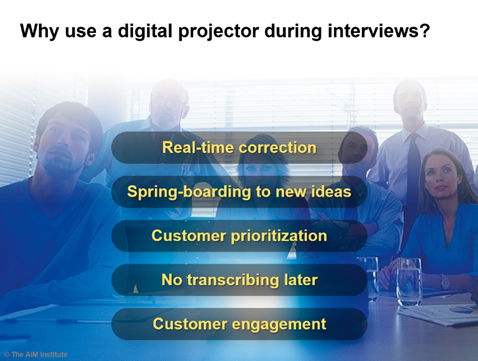You'll sub-optimize if you fail to use a digital projector. Here's why.
In 2005, The AIM Institute pioneered the use of digital projectors to capture B2B customer insights in Discovery interviews. Since then, tens of thousands of digitally-projected Blueprinting interviews have taken place around the world. In some cases, teams have been reluctant because this approach seems “different.” Please don’t skip this important part of gathering B2B insight. It’s proven incredibly helpful for several reasons:

- Real-time correction: When you conduct Discovery interviews, you should use a Moderator to ask probing questions and a Note-taker to record customer responses… which are digitally projected on a screen or wall. The customer is encouraged to tell the interview team if any of these notes need to be changed. This is much better than just sending your notes to the customer later and asking for revisions. After the meeting, the customer’s attention has turned to other matters… and the supplier loses the opportunity to ask clarifying follow-up questions. What’s more, customers can tell when the supplier “gets it,” and this builds their confidence during the interview.
- Idea spring-boarding: During discovery interviews, our clients project their notes (using Blueprinter® software) in digital “sticky notes” that look like 3M Post-It® Notes. This makes customers feel as though they are in an idea generation or “brainstorming” mode. One of Alex Osborn’s original brainstorming rules was to “build off others’ ideas” … which is why we like to interview several customer contacts at the same time. Since customers can easily see all the ideas when you digitally project them, they can review them, mull over them, connect them in unique ways, and spring-board to new ones.
- Customer prioritization: A good Discovery interview typically results in dozens of customer-generated ideas… or more accurately, desired outcomes (end results customers would like to see). But not all these outcomes are equally important in the customer’s view. When you project your notes, it’s easy to let the customers pick their favorites. In Blueprinting jargon, we call their favorite ideas “Top Picks,” and we ask customers to help us mark sticky notes containing these outcomes. This would be tough to do if the supplier had recorded all these outcomes on his/her laptop or legal pad.
- No transcribing Later: Have you ever been in a brainstorming session where paper sticky notes were stuck onto several sheets of flip-chart paper? At the end of the meeting, someone carefully rolled these sheets into a “bazooka tube” and marched off looking for an unsuspecting person to type the notes. After a fine layer of dust had formed on the tube, the notes were eventually transcribed and distributed to the participants, some of whom vaguely recollected the meeting. It should be much easier than this. If you’ve created your notes digitally, all you need to do is spend a little time with your colleagues in a coffee shop right after the customer interview. Clean up your typos, clarify some thoughts, expand others, and you’re on your way.
- Customer engagement: Usually five to ten minutes into an interview, we see that customers get very engaged… often even leaning forward physically. In many cases, interviews that were scheduled for two hours last three, four, five, or even six hours. Perhaps this is because customers see their ideas treated so respectfully: After all, how often does someone listen carefully to you, ask you intelligent questions about your ideas, record your thoughts for all to see, and keep checking to make sure they’re hearing you correctly? And the customers realize the interview isn’t the supplier’s show… it’s their show. In traditional customer interviews, suppliers ask their questions one by one, and the customer reacts. But in a proper Discovery interview, the supplier asks, “What else would you like to see in your ideal world?” And only the customer knows what will come next. The supplier is just facilitating. So instead of the customer helping the supplier fill in his questionnaire, the supplier is helping the customer speak his mind.
Keywords: digital projector, beamer projector, LCD screen, LCD projector, video projector, customer interview
